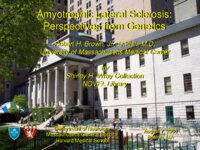Videos, clinical notes and related presentations concerning neuro-ophthalmological and neurovisual disorders collected during Dr. Wray's work as the Director of Neuro-Visual Disorders at Massachusetts General Hospital.
Shirley H. Wray, M.D., Ph.D., FRCP, Professor of Neurology Harvard Medical School, Director, Unit for Neurovisual Disorders, Massachusetts General Hospital.
NOVEL: https://novel.utah.edu/
TO
Filters: Collection: "ehsl_novel_shw"
| Title | History | Type | ||
|---|---|---|---|---|
| 1 |
 |
Alzheimers Disease | The patient is a 78 year old left handed woman with a diagnosis of a left parietal infarct in 1995, bilateral carotid artery stenosis and hypertension. She was first seen in August 1997 for evaluation of involuntary movements of the lower face in the setting of rapidly progressive dementia and was... | Text |
| 2 |
 |
Amyotrophic Lateral Sclerosis (Guest Lecture) | Text | |
| 3 |
 |
Apraxia Eyelid Opening | This patient first presented to his PCP with increasing immobility. A diagnosis of Parkinson's disease was made. When his condition progressed, he was referred to the Neurology Clinic. Neuro-ophthalmological examination showed: Apraxia of eyelid opening Impaired initiation of horizontal saccades ... | Image/MovingImage |
| 4 |
 |
Apraxia of Eyelid Opening | In January 1997, This 73 year old patient was referred to the Neurovisual Clinic. At that time his speech was slurred and he stated that his eyes were his "biggest" complaint due to: 1. Impaired focusing "close up" 2. His eyes shut spontaneously much of the time 3. Bright sunlight provoked eye ... | Image/MovingImage |
| 5 |
 |
Convergence Insufficiency | The patient is a 73 year old man with a ten year history of idiopathic Parkinson's disease characterized by difficulty in walking, generalized rigidity and a mild tremor of his hands at rest with deterioration in his handwriting. He denied any memory impairment or loss of cognitive function. He w... | Image/MovingImage |
| 6 |
 |
Convergence Insufficiency | The patient is a 58 year old man with idiopathic Parkinson's Disease for five years. He presented with an increasing shuffling gait, marked bradykinesia, mild to moderate rigidity in all four limbs and impairment in rapid movements of the hands. When he attempted to standup and walk he needed to... | Image/MovingImage |
| 7 |
 |
Convergence Insufficiency | The patient is a 73 year old man with a ten year history of idiopathic Parkinson's disease characterized by difficulty in walking, generalized rigidity and a mild tremor of his hands at rest with deterioration in his handwriting. He denied any memory impairment or loss of cognitive function. He w... | Text |
| 8 |
 |
Familial Amyotrophic Lateral Sclerosis | This 58 year old woman was referred to Dr. Robert Brown in March 1995 for evaluation of slurred speech. She remained under his care until her death. On examination she had signs of a pseudobulbar palsy: Dysarthria and dysphagia Diminished palatal movement... | Text |
| 9 |
 |
Frontotemporal Dementia | The patient is a 68 year old right handed retired air conditioner repair man who presented with impaired balance and slow walking. For about one year he had noted difficulty lifting his feet high enough when climbing the stairs. From that time on, his movements slowed and worsened so that he had ... | Text |
| 10 |
 |
Gaucher's Disease | This little boy has Gaucher's disease. Gaucher's disease is an autosomal recessive disorder, linked to chromosome 1q21, due to glucocerebroside β-glucosidase deficiency. There are three phenotypic variances of Gaucher's disease. Type I is the most common and lacks neurological features. Type 2 is... | Image/MovingImage |
| 11 |
 |
Global Supranuclear Paralysis of Vertical Gaze | This case was presented to the Clinical Eye Movement Society at the American Neurological Association Meeting in October 2007. The patient is a healthy, 36 year old Lieutenant Commander in the Coast Guard who was last seen perfectly well at 2 a.m. on the day of admission. He awoke in the morning ... | Image/MovingImage |
| 12 |
 |
Normal Eye Movements | The video of the normal eye movement examination was made with the assistance of Dr. Terrence Millette, a neurologist and former Fellow with me in 1985-1986. Introduction to the Saccadic System Saccades are fast eye movements that bring the image of an object of interest onto the fovea. They c... | Image/MovingImage |
| 13 |
 |
Pendular Horizontal Oscillations | This 37 year old woman has had progressive multiple sclerosis (MS) affecting the cerebellum and brainstem for 6 years. Neurological examination: Titubation Dysarthria Incoordination of the extremities Ataxic gait Spastic paraparesis with generalized hyperreflexia and extensor plantar responses. ... | Image/MovingImage |
| 14 |
 |
Pendular Oscillations | This 37 year old woman has had progressive multiple sclerosis (MS) affecting the cerebellum and brainstem for 6 years. Neurological examination: Titubation Dysarthria Incoordination of the extremities Ataxic gait Spastic paraparesis with generalized hyperreflexia and extensor plantar responses. ... | Text |
| 15 |
 |
Saccades (Guest Lecture) | Text | |
| 16 |
 |
Saccadic Initiation Deficit of Horizontal Saccades | The patient is a 68 year old right handed retired air conditioner repair man who presented with impaired balance and slow walking. For about one year he had noted difficulty lifting his feet high enough when climbing the stairs. From that time on, his movements slowed and worsened so that he had ... | Image/MovingImage |
| 17 |
 |
Saccadic Initiation Deficit of Horizontal Saccades | The patient is a 78 year old left handed woman with a diagnosis of a left parietal infarct in 1995, bilateral carotid artery stenosis and hypertension. She was first seen in August 1997 for evaluation of involuntary movements of the lower face in the setting of rapidly progressive dementia and was... | Image/MovingImage |
| 18 |
 |
Slow Saccade Syndrome | The patient is a 62 year old woman referred from Ireland with a one year history of unsteadiness walking which she first noted following a fall from a chair. Her gait disorder was insidious in onset and may have pre-dated the fall. Since then she had become increasingly unsteady with a tendency to f... | Image/MovingImage |
| 19 |
 |
Slow Saccade Syndrome | In 1992, this 60 year old woman realized that she was "slowing up", dragging her right foot and walking slowly, and her speech became slurred. She saw a number of physicians and was given the diagnosis of Parkinson's disease and started on Sinemet 50/200 t.i.d. In January 1994, she was seen by a n... | Image/MovingImage |
| 20 |
 |
Spastic Cerebellar Ataxia of Charlevoix-Saguenay | The patient is a 19 year old high school student who carried the diagnosis of autosomal recessive spastic cerebellar ataxia of Charlevoix-Saguenay. He was born at term, walked at 9 months and developed well with normal milestones. At age 10 he began to have difficulty speaking, occasional involuntar... | Image/MovingImage |
| 21 |
 |
Supranuclear Paralysis of Up and Downgaze | This patient presented to the Dementia Clinic for evaluation of forgetfulness, impaired recall memory, lack of attentiveness and spontaneity and progressive impairment of mobility over a period of one year. Neurological examination: The patient was found to have multisystem involvement with: 1. Mi... | Image/MovingImage |
| 22 |
 |
Supranuclear Paralysis of Upgaze | This 84 year old woman carried the following diagnoses: 1. Extrapyramidal movement disorder; Parkinson's disease vs. Progressive supranuclear palsy 2. Hypertension 3. Recurrent left Bell's palsy In 1992, the patient and her family noted that she was drifting to the right when driving. She progress... | Image/MovingImage |
| 23 |
 |
Supranuclear Paralysis of Vertical Gaze | This case was presented to the Clinical Eye Movement Society at the American Neurological Association Meeting in October 2007. The patient is a healthy, 36 year old Lieutenant Commander in the Coast Guard who was last seen perfectly well at 2 a.m. on the day of admission. He awoke in the morning ... | Text |
| 24 |
 |
Supranuclear Vertical Gaze Palsy | The patient is a 60 year old woman who was given a diagnosis of Progressive supranuclear palsy six months before she was referred by the Movement Disorders Clinic for evaluation of difficulty reading. Family History: Negative for neurodegenerative disease. Neuro-ophthalmological examination: Sup... | Image/MovingImage |
| 25 |
 |
Supranuclear Vertical Gaze Palsy | This 58 year old woman was referred to Dr. Robert Brown in March 1995 for evaluation of slurred speech. She remained under his care until her death. On examination she had signs of a pseudobulbar palsy: Dysarthria and dysphagia Diminished palatal movement... | Image/MovingImage |
